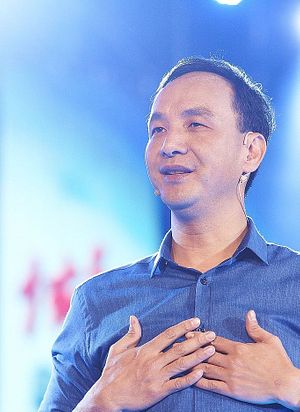One of the many differences between the Taiwanese and Mainland Chinese political systems — in the former, the current chair of the ruling party and the president are different people; in the latter they are one and the same. While President Ma Ying-jeou is the real holder of power on the island, his own party, the Chinese National Party or KMT, is chaired by Eric Chu. For the Communist Party across the Taiwan Strait, these functions are all currently combined in the figure of the general secretary of the Communist Party, Xi Jinping, who also serves as president.
One opportunity this difference does open up is that, on May 3, for only the second time since 1949, the leaders of the KMT and Communist Party will meet each other in Beijing. Eric Chu will make the journey to see Xi, following then-KMT Chairman Lien Chan’s historic tour of the PRC in 2005. If Taiwan had the same political arrangement as the mainland — in terms of leadership of party and state being the same — then this party-to-party meeting would not be possible.
The fact that President Ma himself will not be traveling north means this meeting has attracted less attention than it deserves. Despite Chu’s lower protocol level, this is a major historic moment. It marks the culmination of almost a decade of gradual cross strait détente. And it also heralds in a time when Taiwan and China have started thinking about their relationship with each other in a very different way.
While Xi will be the person hosting Chu in Beijing, the very fact the visiting dignitary will be there at all is due to efforts initiated by Xi’s predecessor, Hu Jintao. Hu’s star seems to fade by the day, and he runs the risk of being consigned to the same forgotten nook of elite politics as Hua Guofeng, Mao Zedong’s chosen successor three decades before and someone who enjoys scant historic influence and recognition today. Like Hua, Hu is perhaps being dealt with a bit unjustly. The space he opened up to speak to Taiwan, to negotiate the Economic Cooperation Framework Agreement in 2010, and to mandate on the Chinese side direct air and postal links, securing opportunities for more Chinese to visit Taiwan, wholly changed the fractious relationship that prevailed before. Ma Ying-jeou showed plenty of courage in pushing forward these closer links with the mainland, but Hu provided the reciprocating chances.
They were not easy chances to create. Under Jiang Zemin, the shrill response of the mainland to the first fully free presidential elections in Taiwan in 1996 had been to instigate military “practice” sessions in the seas around the island. Threats continued in 2000, when Chen Shui-bian of the opposition Democratic Progressive Party created history and won power.
The lesson Hu learned from his predecessor was that the one sure way to see your least preferred candidate win in free democratic elections is to issue threats against him or her from the outside. Under Hu, there was a sea change toward quieter, more sustainable diplomacy. Since 2008, trade links across the Strait and people-to-people contacts have increased dramatically. This may well be remembered as Hu’s most significant achievement diplomatically.
This is still a work in progress however, and much depends on just how well Hu’s successor Xi is able to maintain momentum. Eric Chu’s visit is a major landmark, and one that offers the potential to recast the relationship between the two political organizations that have shaped Greater China’s destiny for almost a century.
But don’t start celebrating just yet. Next year, Taiwan will hold presidential elections. The KMT looks very vulnerable at the moment — it received a huge drubbing in local elections late in 2014. Taiwanese look at the outcome of the “one country, two systems” deal in Hong Kong, a framework which has also been offered to them as a model for reunification, and feel disdain and fear. Cozying up to Beijing may well cost the KMT dearly in 2016. So, while the symbolism of Chu’s trek to Beijing is worth noting, it will be a while before we can truly know whether this is a real step forward in mutual recognition and the creation of a sustainable, peaceful outcome for China Taiwan relations — or the KMT’s final, desperate bid for attention.

































